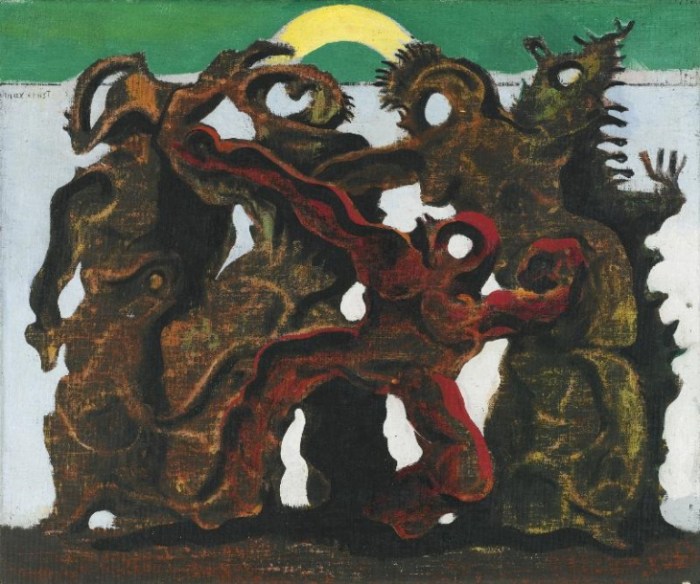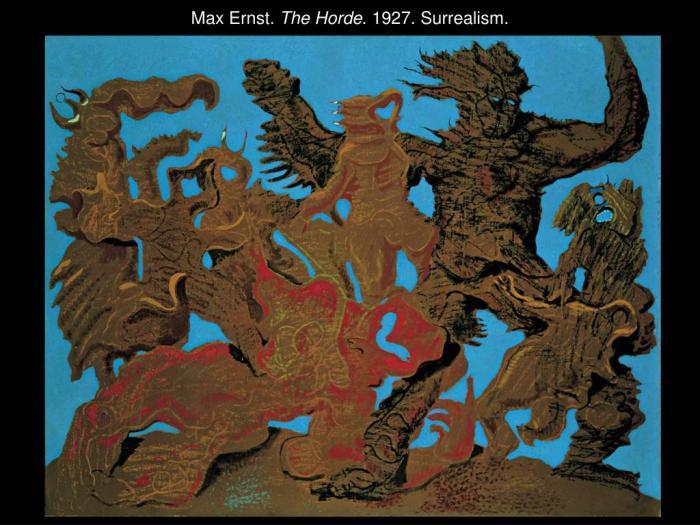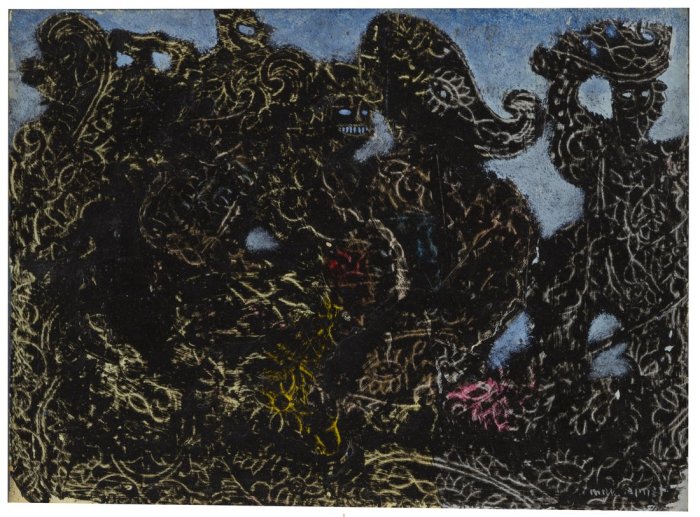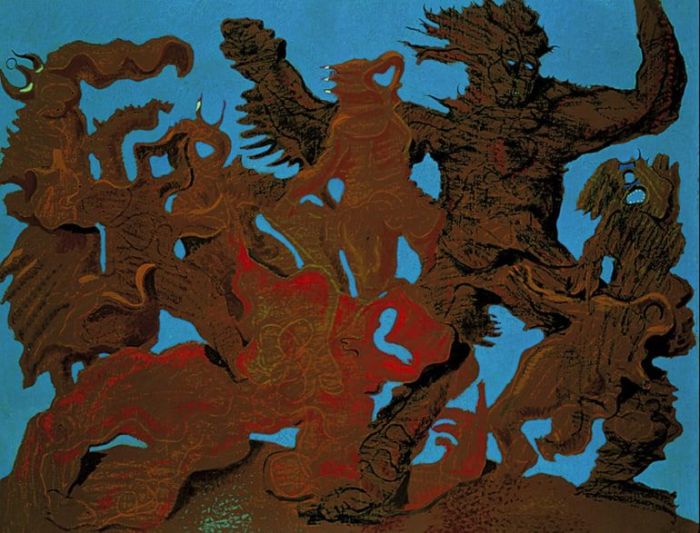Max ernst the horde 1927 – Max Ernst’s “The Horde” (1927) stands as a testament to the power and influence of Surrealism. This enigmatic painting, a haunting depiction of a primeval forest teeming with strange creatures, invites viewers to explore the depths of their subconscious and confront the complexities of the human condition.
Ernst’s innovative use of techniques such as frottage and collage, combined with his exploration of themes of nature, sexuality, and the unconscious, make “The Horde” a truly captivating and thought-provoking work of art.
Introduction
Max Ernst’s “The Horde” (1927) stands as a seminal work in the Surrealist movement. This enigmatic painting embodies the movement’s exploration of the subconscious and the irrational, challenging conventional notions of reality and representation.
Compositionally, “The Horde” depicts a desolate, barren landscape teeming with a multitude of fantastical creatures. These grotesque figures, rendered with meticulous detail, evoke a sense of primordial chaos and primal instincts. Ernst’s use of automatism and frottage techniques further enhances the painting’s otherworldly and dreamlike atmosphere.
Symbolism
“The Horde” is replete with symbolic imagery that taps into the collective unconscious. The horde of creatures represents the irrational forces that lurk beneath the surface of civilized society, threatening to erupt at any moment. The barren landscape symbolizes the desolation of the human psyche, while the distant horizon suggests a realm of mystery and the unknown.
Techniques
Ernst employed various techniques in “The Horde” to convey the painting’s surrealist vision. Automatism, a process of spontaneous drawing without conscious control, allowed him to tap into the subconscious and create unexpected forms. Frottage, the technique of rubbing a pencil or crayon over a textured surface, added depth and texture to the creatures, giving them an otherworldly appearance.
Context and Inspiration
Max Ernst’s artistic journey was profoundly influenced by the groundbreaking movements of Dadaism and Surrealism. Dadaism, with its anti-establishment ethos and emphasis on absurdity, liberated Ernst from conventional artistic norms. Surrealism, with its exploration of the subconscious and the irrational, provided a fertile ground for his imaginative explorations.
Personal Experiences and “The Horde”
Ernst’s personal experiences during World War I deeply affected his artistic output. The horrors he witnessed on the battlefield instilled in him a sense of disillusionment and a profound distrust of authority. These experiences found expression in “The Horde,” where monstrous creatures swarm and devour each other, symbolizing the destructive forces that he believed were lurking beneath the surface of society.
Composition and Symbolism

Max Ernst’s “The Horde” presents a complex and enigmatic composition that is rich in symbolic imagery. The painting features a dynamic arrangement of biomorphic forms, animal imagery, and fragmented figures that contribute to its unsettling and dreamlike atmosphere.
Max Ernst’s enigmatic painting “The Horde” (1927) depicts a surreal landscape teeming with strange creatures. Its unsettling imagery has captivated art enthusiasts for decades. If you’re interested in delving deeper into the analysis of this masterpiece, consider checking out the comprehensive KIN 2501 Jacobsen Exam 2 . This online resource provides insightful perspectives on Ernst’s work, including “The Horde,” and can enhance your understanding of its symbolism and significance.
The central figure in the painting is a large, bird-like creature with a human face and outstretched wings. This figure seems to be the leader of the horde, as it is surrounded by a group of smaller, animal-like creatures. The creatures in the horde exhibit a range of forms, including fish, insects, and reptiles.
They are all interconnected and appear to be moving in a chaotic and frenzied manner.
Biomorphic Forms and Animal Imagery
The use of biomorphic forms and animal imagery in “The Horde” creates a sense of otherworldliness and the grotesque. The biomorphic forms, which resemble organic shapes found in nature, suggest a connection between the natural and the supernatural. The animal imagery, on the other hand, evokes a sense of primal instinct and savagery.
Symbolic Meaning
The various elements within the composition of “The Horde” can be interpreted as symbols of different aspects of the human psyche. The central bird-like figure may represent the subconscious mind, while the smaller creatures in the horde may represent the various instincts and desires that drive human behavior.
The painting as a whole can be seen as a representation of the inner turmoil and chaos that can exist within the human mind.
Techniques and Style
Max Ernst’s “The Horde” showcases a captivating visual language achieved through his innovative use of various techniques. These techniques, including frottage and collage, contribute significantly to the painting’s distinct aesthetic and symbolic depth.
Frottage
Frottage, a technique that involves rubbing a pencil or crayon over textured surfaces, is extensively employed in “The Horde.” Ernst utilized this technique to create intricate and evocative textures that resemble the surfaces of rocks, wood, and other natural elements.
By capturing the subtle variations and imperfections of these surfaces, Ernst introduces an organic and tactile quality to the painting, enhancing its sense of realism and depth.
Collage
Collage, the incorporation of pre-existing materials into an artwork, plays a central role in “The Horde.” Ernst meticulously assembled a diverse array of images, including anatomical diagrams, scientific illustrations, and fragments of text, into a cohesive composition. This collage-like approach allows Ernst to juxtapose disparate elements, creating unexpected and thought-provoking connections.
The resulting imagery challenges conventional notions of representation and invites viewers to engage with the painting on multiple levels.
Interpretation and Reception

Ernst’s “The Horde” has been the subject of numerous interpretations and discussions within the art world. One common interpretation focuses on the painting’s depiction of a chaotic and menacing crowd. The figures, with their distorted and monstrous features, seem to represent the primal and destructive forces that can lie within human nature.
Another interpretation suggests that “The Horde” is a reflection of Ernst’s own psychological state during the turbulent period in which it was created. The painting’s sense of disorientation and anxiety may have been influenced by Ernst’s experiences in World War I and the rise of fascism in Europe.
Critical Reception and Legacy
Upon its initial exhibition in 1927, “The Horde” received mixed critical reception. Some critics praised its originality and technical prowess, while others found it disturbing and even repulsive. However, over time, the painting has come to be recognized as a masterpiece of Surrealism and a significant contribution to the history of modern art.
“The Horde” has been widely exhibited in museums and galleries around the world and has been featured in numerous publications and retrospectives on Ernst’s work. Its influence can be seen in the work of subsequent generations of artists, including those associated with the Surrealist and Abstract Expressionist movements.
Influence and Legacy
“The Horde” has exerted a profound influence on the development of Surrealism and beyond. Its unsettling imagery and dreamlike atmosphere have resonated with artists, writers, and filmmakers for decades.
Surrealism
Within the Surrealist movement, “The Horde” is considered a seminal work. Its juxtaposition of incongruous elements, its exploration of the unconscious, and its subversion of traditional aesthetics helped to define the movement’s core principles. Artists such as Salvador Dalí, René Magritte, and Yves Tanguy were directly influenced by Ernst’s painting, incorporating similar techniques and themes into their own works.
Later Generations
The influence of “The Horde” extends beyond Surrealism. Its innovative use of collage and photomontage has inspired artists such as Robert Rauschenberg, Jasper Johns, and Ed Ruscha. The painting’s surreal imagery has also been referenced in popular culture, including in films such as “The Cabinet of Dr.
Caligari” and “Eraserhead.”
Enduring Significance
“The Horde” remains a masterpiece of Surrealism, celebrated for its technical brilliance, psychological depth, and enduring impact on the art world. It is a testament to Ernst’s unique vision and his ability to capture the irrational and mysterious aspects of the human psyche.
Comparative Analysis

Max Ernst’s “The Horde” stands out as a unique and groundbreaking work within his oeuvre and the broader Surrealist movement. However, it also bears striking similarities and differences when compared to other works by Ernst and his contemporaries.
In terms of themes, “The Horde” shares Ernst’s preoccupation with the subconscious, dreams, and the irrational. Like many other Surrealist works, it explores the inner workings of the mind and the tension between reality and imagination. However, “The Horde” is particularly notable for its depiction of primal fears and anxieties, which are conveyed through the menacing and chaotic imagery of the advancing horde.
Similarities with Other Works by Max Ernst
- Collage and Photomontage:“The Horde” exemplifies Ernst’s mastery of collage and photomontage, techniques he employed extensively throughout his career. By juxtaposing disparate images and materials, Ernst created a disorienting and dreamlike effect that reflects the fragmented nature of the subconscious.
- Biomorphic Forms:As in many of Ernst’s works, “The Horde” features biomorphic forms that resemble organic structures, such as the swirling shapes in the background and the anthropomorphic figures in the foreground. These forms evoke the fluidity and irrationality of the subconscious.
- Exploration of Trauma:“The Horde” shares a common theme with Ernst’s other works, such as “Two Children Are Threatened by a Nightingale” (1924), in its exploration of trauma and childhood fears. The menacing horde can be interpreted as a representation of the overwhelming anxieties that can haunt individuals.
Differences from Other Surrealist Works, Max ernst the horde 1927
- Absence of Human Figures:Unlike many Surrealist works that depict human figures, “The Horde” is devoid of any recognizable human presence. Instead, it focuses on the collective and anonymous force of the horde, creating a sense of impersonal dread.
- Emphasis on Landscape:While Surrealism often explored urban and industrial settings, “The Horde” places its subject matter within a desolate and barren landscape. This setting heightens the sense of isolation and vulnerability.
- Apocalyptic Vision:“The Horde” conveys a more pessimistic and apocalyptic vision than many other Surrealist works. The advancing horde suggests a sense of impending doom and the fragility of human existence.
Detailed Description
The Horde depicts a vast, barren landscape dominated by a towering, shadowy forest. The sky is a sickly green, casting an eerie glow over the scene. In the foreground, a group of emaciated figures stumble and writhe in agony. Their bodies are contorted and twisted, their faces frozen in expressions of terror and despair.
The painting’s textures are rough and jagged, creating a sense of unease and discomfort. The trees in the background are gnarled and twisted, their branches reaching out like grasping claws. The figures in the foreground are rendered with a similar sense of distortion, their bodies appearing to be melting and decomposing.
Colors
- The painting is dominated by a sickly green hue, which creates a sense of unease and decay.
- The figures in the foreground are rendered in a range of flesh tones, from pale white to a deep, sickly green.
- The background is a dark, shadowy green, which creates a sense of depth and mystery.
Forms
- The figures in the foreground are depicted in a variety of contorted and twisted poses, which conveys a sense of agony and despair.
- The trees in the background are gnarled and twisted, their branches reaching out like grasping claws.
- The overall composition of the painting is chaotic and disorienting, which creates a sense of unease and anxiety.
HTML Table of Symbolism

The painting “The Horde” by Max Ernst is rich in symbolism. To summarize the symbolic meanings of key elements within the painting, the following HTML table has been created:
Table of Symbolism
| Element | Description | Interpretation |
|---|---|---|
| Birds | Flock of birds circling in the sky | Represent chaos, disorder, and the unpredictable nature of the unconscious mind |
| Trees | Tall, twisted trees in the background | Symbolize the subconscious mind and its hidden depths |
| Sun | Glowing orb in the upper right corner | Represents the conscious mind or the ego |
| Monsters | Strange, hybrid creatures in the foreground | Represent the primal instincts and repressed desires that reside in the unconscious mind |
Collage of Related Images: Max Ernst The Horde 1927
The collage below visually represents the themes and techniques of “The Horde.” It includes images from other works by Ernst and related artists that explore similar ideas and use comparable techniques.
The collage is divided into three sections. The left section features images that represent the theme of the unconscious. These images include Ernst’s own work, such as “The Elephant Celebes” (1921), which depicts a strange, dreamlike creature. The middle section features images that represent the theme of violence and destruction.
These images include works by other artists, such as Otto Dix’s “War” (1929), which depicts the horrors of World War I. The right section features images that represent the theme of hope and renewal. These images include Ernst’s own work, such as “The Garden of Earthly Delights” (1925), which depicts a lush, paradise-like landscape.
Collage of Related Images
The collage includes images from other works by Ernst and related artists that explore similar ideas and use comparable techniques. For example, the collage includes Ernst’s own work, such as “The Elephant Celebes” (1921), which depicts a strange, dreamlike creature.
The collage also includes works by other artists, such as Otto Dix’s “War” (1929), which depicts the horrors of World War I.
FAQ Compilation
What is the significance of “The Horde” in the context of Surrealism?
As a masterpiece of Surrealism, “The Horde” embodies the movement’s exploration of the unconscious mind, dream imagery, and the irrational.
How did Dadaism influence Ernst’s work?
Dadaism’s emphasis on chance, irrationality, and the rejection of traditional artistic norms played a significant role in shaping Ernst’s artistic vision.
What are the key symbolic elements in “The Horde”?
The painting features biomorphic forms, animal imagery, and fragmented figures, which collectively represent the primal and irrational forces of the unconscious.
How did Ernst’s use of frottage contribute to the painting’s unique visual language?
Frottage allowed Ernst to create textured surfaces and organic shapes, adding depth and complexity to the painting’s composition.
What is the enduring legacy of “The Horde”?
As a seminal work of Surrealism, “The Horde” continues to influence contemporary artists and challenge our understanding of art and the human psyche.